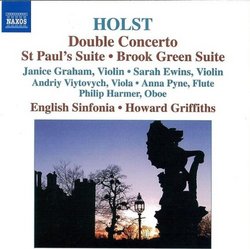Extraplanetary Holst
J Scott Morrison | Middlebury VT, USA | 07/06/2007
(5 out of 5 stars)
"Gustav Holst (1874-1934)is best known, outside England anyway, for his sensationally popular orchestral suite 'The Planets.' Few casual music-lovers know any of his other works and certainly there is nothing else that resembles 'The Planets' in his oeuvre. But he wrote a good deal of music that is neatly made and ultra-English in character. He studied English folksong assiduously, as did his great friend Ralph Vaughan Williams, and much of his music quotes folksong or contains folksong-like melodies that Holst himself invented. That is very much the case in much of the music presented on this CD.
The 'Brook Green Green Suite' (1933) was among the last things he wrote and indeed he wrote most of it while in the hospital. It is primarily for strings although there are optional parts for flute, oboe and clarinet, omitted in this performance. The suite consists of three movements -- Prelude, Air, and Dance -- that frolic and glimmer in the characteristic bright English morning light. The last movement is a siciliano that nonetheless sounds English, not Italian.
'A Song of the Night for Violin and Orchestra' (1905) wasn't published until half a century after Holst's death. This eight-minute piece opens with a mournful violin cadenza that, after a virtuosic middle section, returns in etiolated form at the end. The fine soloist here is Janice Graham who is also the new artistic director of the English Sinfonia, featured on this album. 'Lyric Movement for Viola and Chamber Orchestra', also written in Holst's last year, was dedicated to that era's leading violist, Lionel Tertis. It, too, opens with a yearning cadenza this time answered by a solo flute. Much of the work is hushed, with muted orchestral strings. The plangent viola solo is played by Andriy Viytovych.
The best-known piece on this CD is Holst's 'St Paul's Suite' (1913), written for the orchestra of St. Paul's School for Girls where Holst taught for many years. The four-movement suite for strings -- Jig, Ostinato, Intermezzo and Finale -- is popular with amateur groups. Particularly catchy is the Finale which uses an obsessively recurring figure (taken from the folksong 'Dargason') which is then combined contrapuntally with 'Greensleeves.' The suite is played with jolly abandon by the excellent English Sinfonia strings under Howard Griffiths.
'A Fugal Concerto for Flute, Oboe and Strings' (1923) is a sprightly contrapuntal three movement work lasting eight minutes. It is quintessentially English in spirit, with a dancing first movement, songful Adagio and a concluding allegro with many off-kilter accents. The excellent soloists are flutist Anna Pyne and oboist Philip Harmer. 'Concerto for Two Violins and Orchestra' (1929) with Janice Graham and Sarah Ewins, violins, opens more dramatically than anything previous on the CD, with portentous bassoons, cello, bass, clarinets and violas with interruptions by the timpani. After the two violin soloists enter the mood softens and we eavesdrop on a bitonal conversation between them. The 'Lament', in 5/4, again features bitonal lines for the two soloists, against muted strings. 'Variation on a Ground' is based on a oddly metered tune that pits the individual rhythms of the soloists against each other. This work has quintessential English melodies and harmonies but is more urban than pastoral. Sound throughout is clear and lifelike.
Recommended for those who want to increase their familiarity with the music of Gustav Holst.
Scott Morrison"

